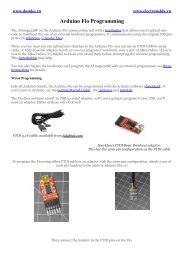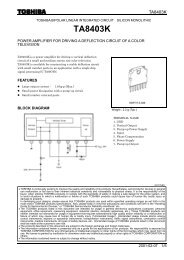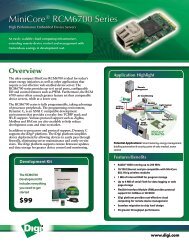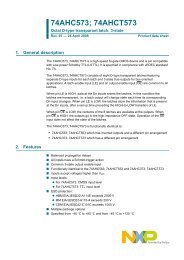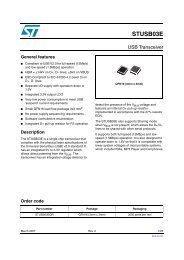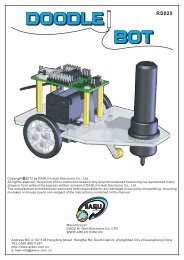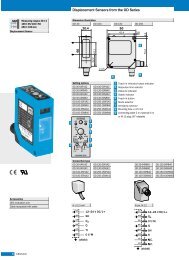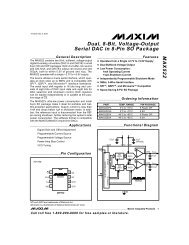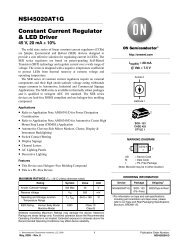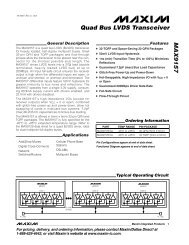- Page 1 and 2: DS2155T1/E1/J1 Single-Chip Transcei
- Page 3: 3 of 242DS21551.1 FEATURE HIGHLIGHT
- Page 7 and 8: 11.3 E1 INFORMATION REGISTERS .....
- Page 9 and 10: 34.5 IDENTIFICATION REGISTER ......
- Page 11 and 12: Figure 37-11 TRANSMIT SIDE TIMING..
- Page 13 and 14: DS21553.1 DOCUMENT REVISION HISTORY
- Page 15 and 16: LINE INTERFACE UNIT Figure 4-2DS215
- Page 17 and 18: BACKPLANE INTERFACE Figure 4-4DS215
- Page 19 and 20: DS2155Signal Name:TSSYNCSignal Desc
- Page 22 and 23: DS2155Signal Name:RPOSISignal Descr
- Page 24 and 25: 5.6 JTAG Test Access Port PinsDS215
- Page 26 and 27: 5.9 L and G Package PinoutThe DS215
- Page 28 and 29: 5.10 10mm STBGA PackageDS215510mm S
- Page 30 and 31: ADDRESS R/W REGISTER NAMEREGISTERAB
- Page 32: ADDRESS R/W REGISTER NAMEREGISTERAB
- Page 35: DS2155Register Name:PCDR1Register D
- Page 40 and 41: DS21559. CLOCK MAPFigure 9-1 shows
- Page 42 and 43: DS2155Register Name:T1RCR2Register
- Page 44 and 45: DS2155Register Name:T1TCR2Register
- Page 46 and 47: DS215510.2 T1 Transmit Transparency
- Page 48 and 49: 10.4 T1 Information RegisterDS2155R
- Page 50 and 51: DS215511. E1 FRAMER/FORMATTER CONTR
- Page 52 and 53: DS2155Register Name:E1TCR1Register
- Page 54 and 55:
DS215511.2 Automatic Alarm Generati
- Page 56 and 57:
E1 ALARM CRITERIA Table 11-2DS2155A
- Page 59 and 60:
DS2155Register Name:IMR2Register De
- Page 61 and 62:
DS2155Register Name:IMR3Register De
- Page 63 and 64:
DS2155Register Name:IMR4Register De
- Page 65 and 66:
DS2155Register Name: IOCR2Register
- Page 67 and 68:
DS2155Bit 3/Local Loopback (LLB). I
- Page 69:
DS2155Register Name:PCLR3Register D
- Page 73 and 74:
15.2 Path Code Violation Count Regi
- Page 75 and 76:
DS2155Register Name:FOSCR1Register
- Page 77 and 78:
16.2 Receive DS0 Monitor RegistersD
- Page 79 and 80:
DS215517.1.1 Processor-Based Receiv
- Page 81 and 82:
DS2155Register Name:Register Descri
- Page 83 and 84:
DS2155Register Name:Register Descri
- Page 85 and 86:
DS215517.2.1.1 T1 ModeIn T1 ESF fra
- Page 87 and 88:
DS2155Register Name:Register Descri
- Page 89 and 90:
DS2155Register Name:Register Descri
- Page 91 and 92:
DS2155Register Name:SSIE3Register D
- Page 93 and 94:
DS215517.2.4 Hardware-Based Transmi
- Page 95 and 96:
18.1 Idle Code Programming Examples
- Page 97 and 98:
DS2155Register Name:TCICE3Register
- Page 99 and 100:
DS215519. CHANNEL BLOCKING REGISTER
- Page 101 and 102:
DS2155Register Name:TCBR3Register D
- Page 103 and 104:
DS2155Register Name:Register Descri
- Page 105 and 106:
20.1 Receive SideSee the IOCR1 and
- Page 107 and 108:
DS215521. G.706 INTERMEDIATE CRC-4
- Page 109 and 110:
DS2155Register Name:Register Descri
- Page 111 and 112:
DS2155Register Name:IMR8Register De
- Page 113 and 114:
DS2155Register Name:Register Descri
- Page 115 and 116:
DS215523.3 Internal Register Scheme
- Page 117 and 118:
DS2155Register Name:Register Descri
- Page 119 and 120:
DS2155Register Name:Register Descri
- Page 121 and 122:
DS2155Register Name:Register Descri
- Page 123 and 124:
DS2155Register Name:Register Descri
- Page 125 and 126:
DS2155Register Name:Register Descri
- Page 127 and 128:
HDLC CONTROLLER REGISTERS Table 24-
- Page 129 and 130:
DS2155Register Name:Register Descri
- Page 131 and 132:
24.3 HDLC MappingDS215524.3.1 Recei
- Page 133 and 134:
24.3.2 TransmitThe HxTCS1-HxTCS4 re
- Page 135 and 136:
DS2155Register Name:SR6, SR7Registe
- Page 137 and 138:
DS2155Register Name:Register Descri
- Page 139 and 140:
24.3.5 HDLC FIFOSDS2155Register Nam
- Page 141 and 142:
DS2155Register Name:Register Descri
- Page 143 and 144:
DS215525. LINE INTERFACE UNIT (LIU)
- Page 145 and 146:
DS215525.2.2 Receive G.703 Section
- Page 147 and 148:
DS2155an accuracy of ±32ppm for T1
- Page 149 and 150:
E1 ModeDS2155L2 L1 L0 APPLICATION N
- Page 151 and 152:
DS2155Register Name:LIC2Register De
- Page 153 and 154:
DS2155Register Name:LIC4Register De
- Page 155 and 156:
DS2155Register Name:SR1Register Des
- Page 157 and 158:
25.8 Recommended CircuitsDS2155BASI
- Page 159 and 160:
25.9 Component SpecificationsDS2155
- Page 161 and 162:
JITTER TOLERANCE (T1 MODE) Figure 2
- Page 163 and 164:
OPTIONAL CRYSTAL CONNECTIONS Figure
- Page 165 and 166:
DS2155Register Name:TCD1Register De
- Page 167 and 168:
DS2155Register Name:RDNCD1Register
- Page 169 and 170:
DS2155Register Name:RSCD1Register D
- Page 171 and 172:
27.1 BERT Register DescriptionDS215
- Page 173 and 174:
DS2155Register Name:Register Descri
- Page 175 and 176:
DS2155Register Name:IMR9Register De
- Page 177 and 178:
DS215527.3 BERT Bit CounterOnce BER
- Page 179 and 180:
DS215528. PAYLOAD ERROR INSERTION F
- Page 181 and 182:
DS215528.1 Number Of Error Register
- Page 183 and 184:
DS215529. INTERLEAVED PCM BUS OPERA
- Page 185 and 186:
IBO EXAMPLE Figure 29-1DS2155RSYSCL
- Page 187 and 188:
DS2155Register Name:ESIBCR1Register
- Page 189 and 190:
DS2155Register Name:ESIB1Register D
- Page 191 and 192:
DS215532. FRACTIONAL T1/E1 SUPPORTT
- Page 193 and 194:
DS215534. JTAG-BOUNDARY-SCAN ARCHIT
- Page 195 and 196:
DS2155Select-IR-ScanAll test regist
- Page 197 and 198:
DS215534.1 Instruction RegisterThe
- Page 199 and 200:
DS215534.2 Test RegistersIEEE 1149.
- Page 201 and 202:
BIT PIN SYMBOL TYPE CONTROL BIT DES
- Page 203 and 204:
RECEIVE SIDE ESF TIMING Figure 35-2
- Page 205 and 206:
RECEIVE SIDE 1.544MHz BOUNDARY TIMI
- Page 207 and 208:
TRANSMIT SIDE D4 TIMING Figure 35-6
- Page 209 and 210:
TRANSMIT SIDE BOUNDARY TIMING (With
- Page 211 and 212:
DS2155TRANSMIT SIDE 2.048MHz BOUNDA
- Page 213 and 214:
RECEIVE SIDE BOUNDARY TIMING (With
- Page 215 and 216:
RECEIVE SIDE BOUNDARY TIMING, RSYSC
- Page 217 and 218:
RECEIVE IBO FRAME INTERLEAVE MODE T
- Page 219 and 220:
TRANSMIT SIDE TIMING Figure 35-18DS
- Page 221 and 222:
TRANSMIT SIDE BOUNDARY TIMING, TSYS
- Page 223 and 224:
TRANSMIT IBO CHANNEL INTERLEAVE MOD
- Page 225 and 226:
36. OPERATING PARAMETERSDS2155ABSOL
- Page 227 and 228:
37. AC TIMING PARAMETERS AND DIAGRA
- Page 229 and 230:
MOTOROLA BUS TIMING (BTS = 1 / MUX
- Page 231 and 232:
INTEL BUS READ TIMING (BTS = 0 / MU
- Page 233 and 234:
37.3 Receive Side AC Characteristic
- Page 235 and 236:
RECEIVE SIDE TIMING, ELASTIC STORE
- Page 237 and 238:
37.4 Transmit AC CharacteristicsDS2
- Page 239 and 240:
TRANSMIT SIDE TIMING, ELASTIC STORE
- Page 241 and 242:
38. MECHANICAL DESCRIPTIONSDS215538



